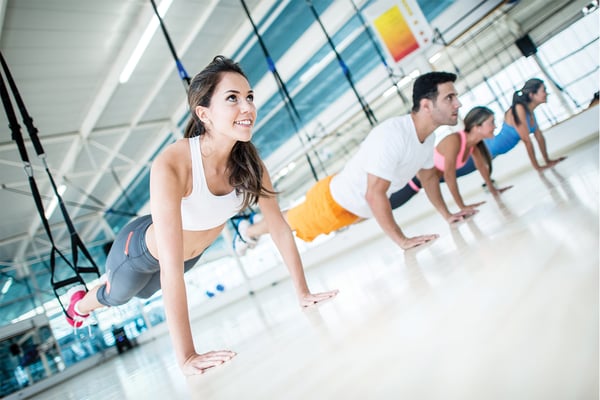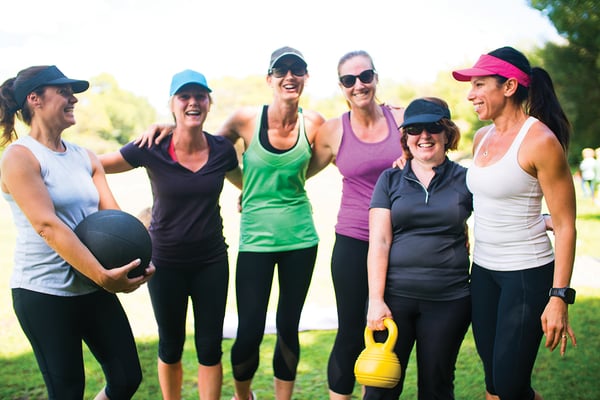
In a perfect world, every fitness facility could offer each class at multiple ability and intensity levels, or custom-tailored to each individual’s ailments and injuries. But in reality, group fitness instructors must teach to participants with a vast spectrum of fitness levels and biomechanical issues, all in one class!
It’s a major difference between group fitness and personal training, and it can have a significant impact on the safety and effectiveness of each individual’s workout. Whether you are a new instructor seeking pointers on when and how to modify, or a veteran instructor looking for some fresh ideas, here are four rules to keep in mind when you modify. Put them into practice in your group classes, and you can help ensure every client is getting a workout that meets their needs.
Rule 1: Watch, Observe and Modify
In order to be an effective group exercise instructor, no matter the modality, you must truly see your participants. When you do, you will be better able to anticipate which exercises need adjustments and how to prepare participants to perform them properly.
Check your awareness. Ask yourself: What is the average skill level of my class? Which individuals need to be challenged? Which have specific biomechanical issues I should be mindful of? If you cannot answer these questions, you might not be really seeing your class. Try to glean answers to these questions during your next session.
Change your point of view. First, be sure the environment allows you to literally see each participant. Setting the mood with lighting is fine, so long as you can still observe participants’ movement patterns. If you are on a stage, step down and work the room sometimes, checking participants’ form and interacting with them.
When showing choreography with your back to the class, use the mirror to make eye contact and scan the room to check if they’re using proper form. Also simplify some of your movements so that you can face your class and mirror-image them, at least some of the time.
Make adjustments on the fly. During class, you must act—often fairly quickly—based upon your observations. This can be difficult, even frustrating. You may have spent hours planning the perfect choreography, and then your participants are just fumbling through it—or standing there, gaping.
The oblivious or stubborn instructor plows ahead, thinking, “They’ll get it next time.” The problem is, the participants might not show up for a next time. That’s one reason a wise and ready instructor watches, observes and modifies.
Rule 2: Start Simply, Add Slowly
What’s the secret to modifying during class without the workout feeling too choppy or too full of options? Start with the basics, and modify up gradually. Don’t be too hard on yourself, though: If you realize midway through class that your workout is too complex, it’s okay. Better to modify down than to not modify at all!
Don’t be too hard on yourself, though: If you realize midway through class that your workout is too complex, it’s okay. Better to modify down than to not modify at all!
Start with the basics. Base moves are those staple movements that serve as the point of origin for all other exercises in a particular modality. A base move for a dance-fitness class might be a step-touch. The step-touch can increase in complexity by changing the arms, double-stepping in each direction, or changing the leg movement from a “touch” to a hamstring curl or knee lift.
A base move in a HIIT class might be a high plank, which can be advanced by adding leg movements like jacks or single arm raises. If you discover a new exercise you want to try in your class, determine what the base move is, and make sure you perform this base move first, either in the warm-up or when setting up the new exercise.
Increase complexity, one step at a time. After showing the class the base move, start with the simplest element to change—typically, arm movement patterns. Then show them a lower body option and, last, add any directional and/or tempo changes. Avoid switching multiple elements at once, unless there’s a combo that’s fairly simple and natural, like an arm-leg movement that’s easy for people to pick up.
Experiment with demo strategies. Here are a few different ways to change things up without confusing or frustrating your class. Always remind class members that each modification is optional.
- For fast-paced choreography, show modifications at half-time, or continue repetitions until the majority of class members have mastered the new movement pattern.
- Have participants do a base move while you demonstrate a modification. In a dance-fitness class, for example, keep class members doing side steps while you demonstrate the mambo cha-cha.
- Show modifications as you go. Start everyone at step 1 (like single squats), then offer step 2 (squat jumps), then offer step 3 (lateral squat jumps), and so on.
- Demonstrate alternatives during a brief recovery period. In indoor cycling class, for example, use a recovery segment to explain that a seated easy climb is a good modification for people who need a break during the upcoming long standing climb.
Remember, your participants are there to work out, so it’s vital to keep them moving as much as possible. Modifications should enhance and improve the workout.
Rule 3: Modify with Purpose
Choose which moves warrant specific modifications. For many exercises, the modification is simple: You make the movement either bigger or smaller. For others, you may need to provide a preparatory movement instead. Use these guidelines to help you decide on your next move.
Consider the AFAA 5 Questions. For each exercise, you need to remember: What is the purpose of this exercise? Are you doing that effectively? Does the exercise create any safety concerns? Can you maintain proper alignment and form for the duration of the exercise? For whom is the exercise appropriate or inappropriate? Once you have decided that an exercise is a safe and effective one for the class as a whole, you can consider what the alternative might be for any participants who find that exercise contraindicative.
Think about the members. When you know participants well, you are aware of who has wrist issues, who had recent shoulder surgery, who just had a baby, and so on…and you can anticipate which exercises might be too difficult for whom.
Some modifications can be given directly to an individual, either before class has started or as you work the room during the workout. But because we often have new participants—and because even our “regulars” vary in their abilities from day to day—it’s prudent to give most modifications to the entire class.
Modify with purpose. When modify-ing an exercise, the modification should serve a similar purpose, utilize the same muscles, and/or follow a similar movement pattern. Consider these questions:
- What is the main purpose of this exercise? (Is it simply to get the heart rate up? Is it to strengthen a particular muscle group—and if so, is the focus on isometric, isotonic or plyometric strength?)
- What are the main elements of this exercise? What are the prerequisites to master it?
- What is the best progression for this exercise, or what is an alternative exercise that is simpler but works toward the same purpose? (See “Modifying a Burpee” for a sample question-and-answer exchange.)
(See “Modifying a Burpee” for a sample question-and-answer exchange.)
Remember: If you are teaching a pre-choreographed format, it’s still important to ask these questions and to practice variations of the choreography.
This way, when you observe a participant struggling, it will be easier for you to simplify the movement patterns without losing your place in the music or getting over-whelmed. When you modify with purpose, your entire class will still be working on the same goal but in different ways.
When you observe a participant strug-gling, it will be easier for you to simplify the movement patterns without losing your place in the music or getting over-whelmed. When you modify with pur-pose, your entire class will still be working on the same goal but in different ways.
What’s important is that clients are challenging themselves and honoring their bodies and any biomechanical issues they may be dealing with.

Rule 4: Establish an Inclusive Environment
It does no good to prepare and offer perfect modifications if no one chooses to follow them. You as the instructor need to foster an environment where every class member feels comfortable working at an appropriate self-assessed level. Some ways to ensure this:
Demonstrate all the levels, not just the hardest.
It’s important to make sure the class is all about “doing what you can,” rather than everyone doing things in unison. Remind participants that it doesn’t matter what variation they are doing. What’s important is that they are challenging themselves and honoring their bodies and any biomechanical issues they may be dealing with.
Offer some praise. As the instructor, you should make sure that no one feels foolish, weak or less-than when they perform modifications. Instead, praise participants for being mindful and listening to their bodies.
Rethink how you talk about modifications.
Rather than using labels like “beginner” and “advanced,” talk specifically about the exercise’s intent, like “If you have shoulder issues, do this instead.” Often it’s our strongest athletes who come in with the worst injuries.
Labeling an exercise “beginner” might cause participants to shy away from a much-needed modification. On the other hand, designating it “a good alternative if you have tight hips today” is specific and acknowledges that each day we are different. It’s not about judging our bodies but exercising them safely and with integrity.
All instructors, no matter the format or brand, need to know how to meet their participants where they are, providing options when necessary to ensure safety, effectiveness and an inclusive environment. By following these four rules, you can ensure that modifications aren’t just an afterthought but a vital element of your class success.
Modifying a Burpee
A burpee is a great exercise, but many participants may struggle with it. Rather than skip it altogether, you can provide a sensible sequence that prepares each participant for the ultimate move…while also leaving it optional.
What is the main purpose of this exercise? A burpee improves strength of the lower body, upper body and core with plyometric muscle contractions, while also challenging the cardiorespiratory system.
What are the main elements of this exercise? A burpee consists of a squat jump, a plank hop and a push-up.

What are the prerequisite moves, and what is the best progression? Squat jumps offer a great way to begin, because this part of a burpee is plyometric and taxes the cardiorespiratory system.
For anyone who cannot perform high-impact exercise, demonstrate simple air squats without the jump, which still strengthens the leg muscles in the sagittal plane.A second exercise could be plank hops, which are also plyometric. Then try adding the plank hop to the squat jump. Or add a pushup to a plank hop.
Finally, you could offer the option of doing actual burpees, or participants could stay with a previous exercise.


